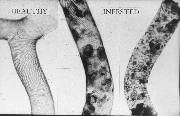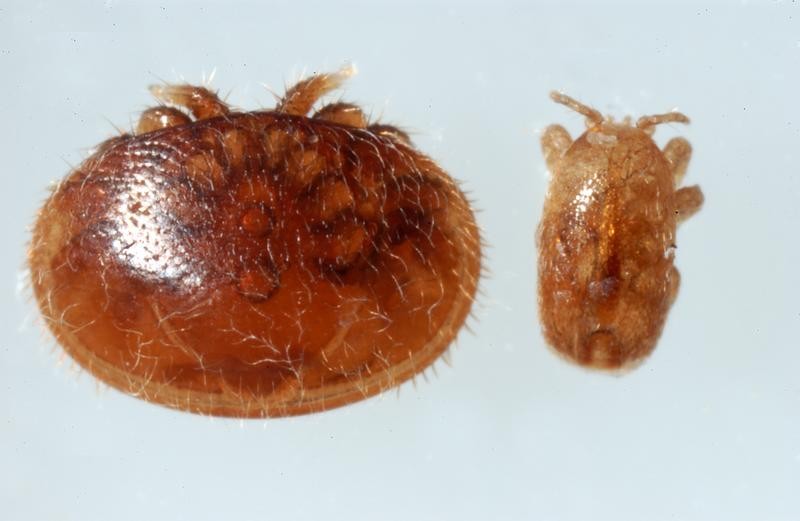A strategy that can be used with just about every bee disease/pest is called Integrated Pest Management or IPM. The Northeastern IPM Center is located within Cornell University and is a good resource. The Maine and Massachusetts State Apiarists in 2020 did a four-part Webinar on Varroa mite IPM for the Northeastern IPM Center.
Health threats to bees
On many bee health sites it is common to provide a bunch of over copied information about bee diseases and pests. Rather than repeating what is already published, this site contains Maine specific information and links to more.
The State Apiarist should be notified of occurrences of reportable diseases by E-Mail or Telephone.
American Foulbrood (Paenibacillus larvae)
Courtesy The Animal and Plant Health Agency (APHA), Crown Copyright
Courtesy The Animal and Plant Health Agency (APHA), Crown Copyright
Often called by its initials, AFB
Rare in Maine.
Several incidents were reported in Maine in 2023; most were related to long-stored equipment. A contagious bee disease that should be reported to the state Apiarist; after lab confirmation of the disease, infected colonies and their hives must be destroyed by burning.
Penn State University Cooperative Extension
Bee Aware (Australia) web page about AFB
Bee Informed Blog Post “What is that Smell” by Rob Snyder
Video by Beekeeping.IsGood.ca via YouTube– “Learn to identify American foulbrood in 90 seconds”
Honey Bee Health Coalition - Managing Foulbrood (updated 11/22)
European Foulbrood (Melissococcus plutonius)
Courtesy The Animal and Plant Health Agency (APHA), Crown Copyright
Courtesy of scientificbeekeeping.com
Often called by its initials, EFB
Common in Maine
Extension Bee-Health entry for Europen Foulbrood
Bee Informed Blog Post “European Foulbrood (EFB)” by Rob Snyder
Chalk Brood (Ascosphaera apis)
Courtesy The Animal and Plant Health Agency (APHA), Crown Copyright
Courtesy of scientificbeekeeping.com
Can be common in Maine.
– An opportunistic, somewhat seasonal, disease that is related to colony stress, but is not usually fatal to the colony.
Dave Cushman web page about Chalkbrood
Bee Informed Blog Post “Chalkbrood” by Rob Snyder
Honey Bee Suite Blog Post by Rusty Burlew – “Chalkbrood disease of honey bees”C
Vairimorpha (FORMERLY identified as Nosema) Apis & Ceranae
Dysentery on the top bars of frames. Courtesy The Animal and Plant Health Agency (APHA), Crown Copyright
Apis at 400X under a Microscope. Courtesy The Animal and Plant Health Agency (APHA), Crown Copyright
Ceranae at 400X under a Microscope. Courtesy The Animal and Plant Health Agency (APHA), Crown Copyright
Common in Maine with ceranae replacing apis
Dysentery can be a symptom of Vairimorpha apis but is not a conclusive One!
Vairimorpha cerane mostly has no symptoms though some say “failure to thrive” is one.
An article from the American be Journal posted by its author Randy Oliver on his website scientificbeekeeping.com “Sick Bees – Part 17: Nosema – The Smoldering Epidemic”
MITES
Mites are arachnids, and parasitic to Honey bees. They can be internal (Tracheal) or external (Varroa and Tropilaelaps).
Varroa Mites (Varroa destructor)
Courtesy The Animal and Plant Health Agency (APHA), Crown Copyright (with a Troplipeaps Mite bottom center)
Courtesy The Animal and Plant Health Agency (APHA), Crown Copyright
Very Common in Maine
Varroa mites are a parasitic mite of Honey bees first introduced into the North America about 1987. Left undealt with by a beekeeper, Varroa injures developing bees and are a “vector” for spreading viruses within the colony.
A mite that is sometimes confused with Varroa destructor is Varroa jacobsoni - a Reportable Bee pest in Maine. Varroa jacobsoni is not believed to exist in Maine.
A Paper by Dr. Samuel D. Ramsey et al. “Varroa destructor feeds primarily on honey bee fat body tissue and not hemolymph”
A Video by The Honey Bee Health Coalition via YouTube – “Sampling Methods”
A Video by Bee Aware (Australia) via YouTube “Varroa spread, life cycle and population growth”
A Video by Dr. Peck, et al. “Varroa destructor mite infests bee from a flower”
Tracheal Mites (Acarapis woodi)
Uninfected Trachea on L. Courtesy The Animal and Plant Health Agency (APHA), Crown Copyright
They were very common in Maine, and it is being watched for re-occurrence.
Many of the treatments for the Varroa Mite, are also effective against the Tracheal Mite. The increase in Oxalic Acid Vaporization as a Varroa Mite treatment is thought by some to be tied to an increase in Tracheal Mite cases as the Oxalic Acid particles may not be small enough to reach and kill the mites.
USDA ARS web page about Tracheal Mites
Bee Aware (Australia) web page about Tracheal Mites
Video by Dr. Jamie Ellis, University of Florida, via YouTube – “Tracheal Mite Symptoms”
PDF by Dr. Diana Sammataro, USDA ARS – “An Easy Dissection Technique for Finding the Tracheal Mite”
Website - Cooperative Extension Foundation - Honey Bee Tracheal Mites: Gone? But not for Good
Troplipeaps Mites (Tropilaelaps clareae & Mercedesae)
Size comparison of Varroa destructor (L) & Tropilaelaps clareae (R) Courtesy The Animal and Plant Health Agency (APHA), Crown Copyright
Courtesy The Animal and Plant Health Agency (APHA), Crown Copyright
Not yet found in Maine – Reportable if found
University of Florida “Featured Creature”
Bee Informed Partnership Blog Post “Tropilaelaps Mites” by Jennie Stizinger (2012)
Bee Informed Partnership Blog Post “Tropilaelaps Mites Part 2” by Elinor M Lichtenberg (2013)
Small Hive Beetles (Aethina tumida)
Courtesy The Animal and Plant Health Agency (APHA), Crown Copyright
Courtesy The Animal and Plant Health Agency (APHA), Crown Copyright
Common in Southern and Coastal areas. Becoming more common on the North coast.
Brought into Maine by migratory beekeepers and in packages/nucleus colonies originating in the southern United States. In parts of Maine, they successfully over winter.
eXtension web page about Managing Small Hive Beetles
PDF from Mississippi State University Extension – Small Hive Beetle
USDA ARS project on Small Hive Beetle
Greater (Galleria mellonella) and Lesser (Achroia grisella) Wax Moths
Courtesy The Animal and Plant Health Agency (APHA), Crown Copyright
Courtesy The Animal and Plant Health Agency (APHA), Crown Copyright
Nature’s Clean Up Crew
Often found in stored equipment.
Bee Aware (Australia) web page about Wax Moths
A blog post by Carolina Honeybees – “Wax Moths in Bee Hives : Is it a Death Sentence?”
Mice / Voles / shrews
Courtesy The Animal and Plant Health Agency (APHA), Crown Copyright
Courtesy The Animal and Plant Health Agency (APHA), Crown Copyright
Common in most areas
A blog post from Beekeeping.IsGood (Canada) “Keeping mice, voles, and shrews out of beehives over winter”
Black Bears (Ursus americanus)
Wide Ranging in Maine
A PDF from MAAREC – “Bees and Bears”
Bear Biology from Maine Dept. of Inland Fisheries and Wildlife (web site)
Electric Fencing for Black Bears from Maine Dept. of Inland Fisheries and Wildlife. (PDF)
WASPS
Maine has several yellow and black wasps - the commonly called “yellow jacket.” They are “predatory social wasps of the genera Vespula and Dolichovespula.” - Wikipedia
They differ from bees in that they feed an animal-based protein diet to their developing young, while bees provide a plant-based protein (pollen).
All hornets are wasps but not all wasps are hornets. See Hornet vs Wasp: How to Identify and Tell the Difference
The wasps mentioned below are not in Maine, but are threats from the East (Europe/UK) and the West (Washington State).
Asian Hornet A/K/A Yellow legged hornet (Vespa velutina)
Flickr by Gilles San Martin CC BY-SA 2.0
Not in Maine—Eradication efforts are underway. The USDA confirmed identification in Georgia, USA, in 2023. Some scientists are concerned that even if eradication now is successful, future inadvertent incursions are likely. The range V velutina could exist in likely includes Southern Maine. It was found again in 2024.
Present in Europe and the UK.
A Collection of information about the Asian Hornet from the British Beekeepers Association
Northern Giant Hornet (Vespa Mandarinia)
Not in Maine. Identified in Washington state, USA in 2019. Believed eradicated.
Wikipedia
Colony Collapse Disorder
CCD is a set of symptoms which can be summarized as most of the bees vanish from their hive, leaving the Queen, a few other bees, and plenty of food. The cause – although the subject of much speculation – has never been positively identified. CCD has not been seen in Maine in some years.
You can read a good summary by the EPA of CCD here.

























